The Long Island Rail Road Trainmen's Trio
This musical trio was first organized in 1924 under the sponsorship of the
LIRR, with Jeff Skinner, Johnny Diehl and Matty Balling. They were
very popular, performing at various public and railroad-related events. They
lasted into the early 1930s with Johnny Diehl being replaced by Charlie
Burton after Diehl was let go from the railroad.
Jeff Skinner, born in 1900, joined the railroad for summer employment in
1917,
and "stayed on for 47 more summers" as he used to say. He started as a
"guard" who was a member of the train crew who used to open and close the
doors and platform guards (traps) on the passenger cars. He eventually
advanced to trainman and conductor.
I met Jeff in 1969 after he was retired and writing the Veterans column in
the LIRR newsletter "MetroLines" and he and I became very good friends.
On one occasion, around 1971,we even performed, together, a number of his
old Trainmen's Trio songs at a meeting of the Long Island Sunrise Trail
Chapter of the N.R.H.S. in Babylon. He played the guitar and we both sang
and harmonized.
Jeff was a great influence to me and my railroad interest and he was missed
terribly by many besides myself when he died in 1976.
|
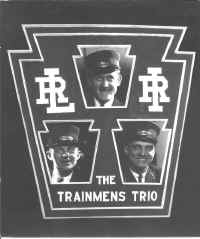
Jeff Skinner Collection |
Song Sheets
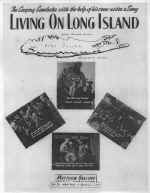
"Living on Long Island"
copyright 1947
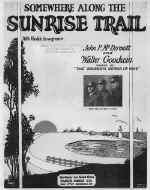
"Somewhere Along the Sunrise Trail"
copyright 1926 |
|
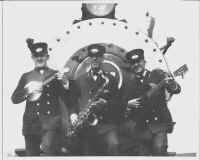
Jeff Skinner Collection
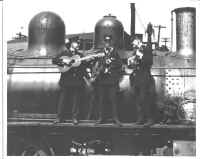
Jeff Skinner Collection
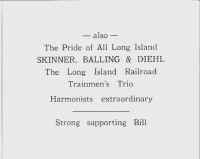
Jeff Skinner Collection |
Communication Failure
This photo, taken by the late Thomas R. Bayles, who was a Long Island Rail
Road ticket clerk at the time, is of E51sa (4-4-2) camelback #4 westbound at
Speonk in 1915.
As one can see, a camelback locomotive differs from a regular locomotive in
that the cab was astride the boiler. The engineer sat on the right
side of the boiler, cut off from the fireman who sat on the left side when
he wasn't shoveling coal into the always-hungry firebox. There were no
radios, so communication between the two enginemen was practically nil.
Retired Long Island Rail Roader George G. Ayling, who was assigned to the
Cental Islip station for many years, both as block operator and later as
agent told me this story.
It seems a Main Line passenger train, pulled by a camelback locomotive was
scheduled for a station stop at Central Islip.
When the train didn't appear to be slowing for the station, the fireman got
a little concerned. When the train ran both the station and the stop
block signal, the fireman thought he had better go see what was going on and
be quick about it!
He got out of the cab on his side of the boiler, walked along the catwalk,
around the back of the locomotive and along the catwalk on the engineer's
side of the locomotive.
When he got to the cab, the engineer was slumped over the throttle, dead.
It was later determined that he had a stroke. The fireman brought the
train to a stop.
Thank God the fireman position wasn't abolished all those years ago!
|
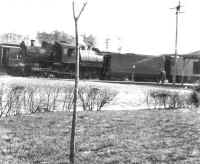
E51sa (4-4-2) camelback #4
westbound at Speonk in 1915
Photo: Thomas R. Bayles
Dave Keller Collection |
Charlie
Jackson, Engineer
Charles T. Jackson was born in 1895. Both his father, Coe Jackson and his
uncle, Parmenus Jackson were L.I.R.R. engineers in the late 19th and early
20th centuries. (Parmenus retired in 1927 I believe.)
I met Charlie in the early 1970s. He and his wife Lily lived in a
large, old house in Greenport that once belonged to his uncle. When I
knew him, he was suffering from the aftermath of a stroke, diabetes and
poorly healed (or performed) prostate surgery. He had a lot of trouble
speaking, but I was patient and learned lots of things from him. He and his
wife were very friendly to a young railfan, and I visited them many Sundays.
Charlie's claim to fame was being (unfortunately) the engineer of E51sa
camelback #2, the second locomotive of that infamous, eastbound
double-header that split a switch on Friday, August 13, 1926 (yes, Friday
the 13th for the superstitious) and plowed into Golden's Pickle Works,
located trackside in Calverton.
The engine crew of the lead locomotive, D16sb #214 died horribly as they
were pinned against the scalding hot firewall. Charlie and his fireman Bill
Squires were thrown clear, but injured. Charlie was flung from the cab
through the cab's skylight which, luckily, was open to get some air and
ventilation on that hot, humid, Long Island day in August.
Charlie said that instead of being taken to the hospital, he was brought,
with broken jaw, to the local police station and interrogated for hours.
Since he was the only surviving engineer, they attempted to blame him for
the disaster.
Bill Squires quit the railroad shortly thereafter, but Charlie stayed on
until retirement in the 1950s. As a result of the wreck, his mouth and jaw
were disfigured and his fellow workers nicknamed him "whalemouth." It
seems making fun of a man's disabilities was a blue-collar pastime even all
those years ago!
Charlie passed away in the late 1970s, and his wife Lily, who so diligently
took care of him throughout his illnesses, followed shortly after.
|
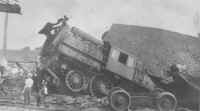
E51sa camelback #2, spun around
180 degrees and buried into Golden's Pickle Works - 8/14/26
C. T. Jackson Collection
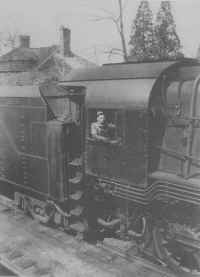
Charlie as engineer at the throttle
of G5s #26 at Manorville, c. 1930
C. T. Jackson Collection
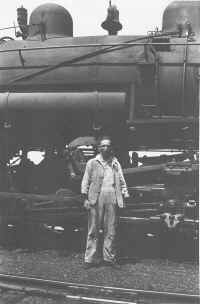
Charlie as a young fireman standing next to
H6sb #312 at Farmingdale in 1918.
C. T. Jackson Collection |
| The
Beginning of a Railfan
My father used to commute via the LIRR from Patchogue to his job as night
shift engineer at Piel Brothers brewery at 315 Liberty Ave. in the East New
York section of Brooklyn. He got to know most of the regular trainmen,
conductors and some engineers who had the various runs from that station.
My mother and I would, on occasion, meet my father at the station when my
mother had need of the car (back in those days, most everyone was a one-car
family).
One of those days was to be momentous for me...
I was about 5 years old and we were waiting on the platform in front of the
old, brick Patchogue station, watching for the eastbound train to arrive
with my father.
When the train arrived, he got off and so did Matty Roeblin, a trainman and
conductor on the LIRR. It was Matty's last day of service and his last
run. He had worked it as a trainman. He knew my father from
their friendly relationship developed over many years of commuting.
When Matty got off the train, he walked up to me alongside my father and
took off his blue serge trainman's cap with badge and his matching vest with
the brass "LI" buttons and handed them to me!
I was somewhat interested in trains around that time, and I guess my father
mentioned my interest in passing to him. When he gave me this
wonderful gift, I was hooked!
I wore them all the time. I even brought them to school in 1st grade,
and, with the assistance of a string of chairs, a paper hole punch and a
bunch of LIRR seat checks from another generous trainman-friend of my
father, the class would all sit in the chairs and I would hand out and punch
their "tickets" (seat checks), as we played train and I told everyone
to "change at Jamaica!"
My interest never waned, but got stronger as the years passed. This is
an example of what a generous deed and positive role model can do for a
child. I've loved the LIRR and everything about it ever since.
This photo is of LIRR Conductor Ed A. Martin and Trainman George Kennedy of
train #507 comparing their pocket watches in preparation of departing Oyster
Bay station in 1952. They are wearing the blue serge uniform with
brass buttons displaying the "LI" logo and their caps are displaying the
brass badges. It is this style cap and vest that I still have in my
collection and treasure the memories. (J. P. Sommer photo)
LIRR weekly commutation ticket used by my father from Patchogue to Flatbush
Ave., Bklyn., 1962. This ticket was purchased in Ronkonkoma, hence the
rubber stamp for "Patchogue". Had the ticket been issued at Patchogue, the
card stock would have been printed with "Patchogue" already on the ticket.
The ticket is pink. Pink designated tickets to Flatbush Ave., Bklyn.
Same commutation ticket, reverse side, showing the Ronkonkoma dater-die
indicating place of purchase of the ticket.
|
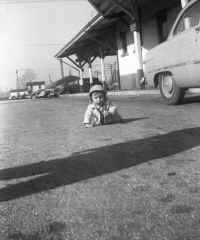
Railfan Dave Keller began his love for the LIRR at an early age. Here
we see Dave in 1952 at 8 or 9 months crawling as fast as he can behind the
old, brick Patchogue Depot to get his camera as a train is about to
arrive.
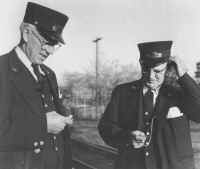
LIRR Conductor Ed A. Martin and
Trainman George Kennedy c1952
J. P. Sommer photo
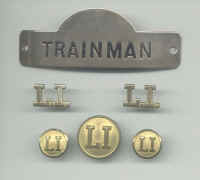
Cap badge, lapel pins and
buttons from the 1950s
Dave Keller Collection
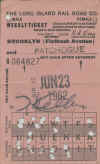 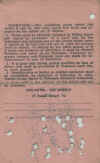
|
Railfanning
at "SG"
I first met George DePiazzy at a Boy Scouts of America function. I
was a young, volunteer Assistant Scoutmaster from Troop 80 in Holtsville, NY
and George was an Assistant Scoutmaster from a Bayport, NY Troop if I
remember correctly.
We got to talking and I discovered he was a block operator for the L.I.R.R.
and assigned to the 1st trick (shift) at "SG" cabin, which was located at
the time on the north side of the tracks and just west of 5th Avenue in
Brentwood. I also discovered that he was the father of two guys with whom I
had gone to high school.
I asked if I might visit him sometime while he was on duty and take some
photos. He said O.K. I visited "SG" cabin and George many times.
I photographed inside the cabin (it had a table block machine: no
Armstrong levers), and out, and took shots of trains getting orders, much as
I did at "PD".
Other railroaders nicknamed George "Dippy", not because he was stupid or
ditzy, but because of the way they would pronounce his last name: "Dippiazzy."
It eventually got shortened to "Dippy."
"SG" cabin was a tiny block office made of block and faced with brick,
replacing the old, wooden cabin south of the tracks and east of 5th Avenue.
George used to work that old cabin in it's last days, and described in
great detail how much "fun" it was having to use the old wooden outhouse, a
common site all over Long Island and the rest of the United States for that
matter.
George used to work "BK" block station at Stony Brook. Once, he was
sitting at the block operator's desk with his headphones on, talking to the
dispatcher during a thunderstorm. A lightning strike came through the
phone lines and went into his ears and blew him off the chair and across the
room, slamming him against the depot wall.
He had no recollection of this event, but was aware of it because he was
told what happened after he had regained consciousness. The story was
confirmed to me by witnesses.
George was an avid and experienced outdoorsman: hunter, boater, fisherman
and camper. He made a great Boy Scout leader. He and I attended
an adult training weekend together in 1972.
On Memorial Day, 1977 he was out fishing with a friend when he noticed a
small boat in trouble. It was stormy weather and the boat appeared to
be sinking. He and his friend put their boat in the water and went out
to assist the vessel.. The people in the boat were inexperienced, and
in attempting to save them, George and his friend banged their heads, lost
consciousness and drowned. He was 48 years old.
When the main line was electrified through to Ronkonkoma and double tracked
around 1987, "SG" cabin was no longer needed and was razed.
The first photo is of the old "SG" cabin c. 1925 looking west, photographed
by block operator James V. Osborne.
The second photo is of the "newer", relocated "SG" cabin looking west in
1969, prior to my having met George. The cabin was closed at the time
I photographed it (it was only open for 1 trick, Monday through Friday, I
believe) and the security shutters were closed. "SG" block signals are
visible in the distance.
The third photo is of operator George DePiazzy throwing the switch for the
long siding at "SG". I took this photo of George in 1972.
The fourth item is a memorial article from Newsday, dated 5/30/77 about the
men who died that day.
|
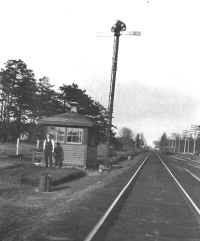
"SG" cabin c. 1925 looking west
J.V. Osborne Photo
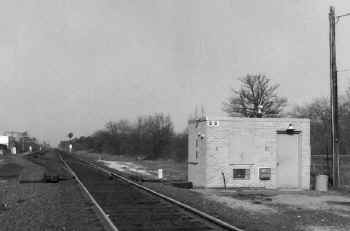
Relocated "SG" cabin looking west in 1969
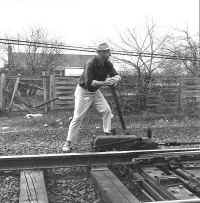
George DePiazzy throwing the switch for the
long siding at "SG"
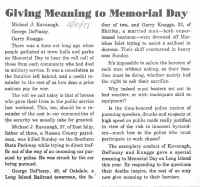
Newsday Memorial Item 5/30/77 |
G.G. Ayling
and "CI"
In 1965 my mother bought me Ron Ziel's book Steel Rails to the Sunrise.
As a young railfan, I spent more time in that book than anywhere else.
Here were photos I had never even imagined existed.
I saw several of them were attributed to G. G. Ayling, the former agent at
Central Islip. Just out of curiosity, I looked in the phone book and
found him listed. I asked if I could visit with him and talk
railroading. He said yes, and that was the beginning of a very close
friendship that lasted until his death 8 years later.
George Graham Ayling was born in N. Y. City on 11/9/1888. His family
moved to Brentwood in May of 1893. As a young man he held various odd jobs
until unofficially starting on the railroad in September of 1909 at the
Brentwood Station. He lived where the present day Long Island
Expressway intersects with Brentwood Road. This was quite a hike on
his bicycle daily to go to work. He learned the freight and express
business along with telegraphy.
In June of 1910 he went to Quogue as a clerk under agent Ira Baker, who, in
later years, was the agent at Amagansett. George then worked a six-week
stint at Westhampton until he got furloughed.
He returned to the LIRR in April of 1911 and reported to work at Central
Islip as a clerk under agent Frank T. Kelly. Still living in Brentwood, he
would ride his bicycle to work and back daily, quite a distance, in all
kinds of weather. He would sneak it through the woods for access to
the Long Island Motor Parkway, to avoid paying tolls.
When Frank Kelly left the railroad, Vern L. Furman became agent, Henry
Nenstiehl became clerk and George became block operator. Back then, all
train movements were handled via telegraph and George became a very
proficient and fast telegraph operator. George was famous for his beautiful
penmanship and it showed, even when he copied a train order.
He must have figured he was here to stay, because he built his house a block
away from the depot in 1919 and lived there until he died.
George succeeded Furman as agent in May of 1923. He was to remain at
"CI" until his retirement on December 21, 1954.
He handled the regular commuter patronage and related baggage and express
duties, in addition to handling interline transactions whereby passengers
would be routed, by train, to just about anywhere in the country. In
addition to these duties, he had the added responsibility of handling the
Central Islip State Hospital with it's deliveries of freight, coal,
merchandise and passengers visiting via train and dead inmates leaving in
coffins. Work hours were from 6:00 am until work was completed,
usually around 7:00pm, 7 days a week.
When first employed, George earned $50.00 per month, with no overtime.
As operator he earned $87.50 per month, and as agent, about $100.00 per
month.
George loved photography and also photographed many scenes of the LIRR when
he was able so we had a common interest. I would visit him and his wife Emma
every Saturday. We would talk railroading, I would drive him and his
wife around, for it had been years since he had gotten out. He was very weak
and feeble of limb and had bad arthritis in his feet and hands. The
hands that wrote that beautiful penmanship were all gnarled and twisted, but
still he attempted to write beautifully.
George also attempted to teach me the American Morse code, the kind used in
railroad telegraphy. I never caught on very well. He would use a
regular telegraph key, and when he wanted to be very fast, a Vibroplex
mechanical key that he had purchased for his own use on the railroad. He
taught me fancy penmanship, told me all kinds of great stories about
railroad and non-railroad things on Long Island and overall we had a great
relationship. At one point, he suggested I call him "gramps" and he
became my adopted grandfather, having never known either of my own.
Then, Emma fell and broke her hip. Their kids hired a nurse to take
care of George. While Emma was in the hospital, George fell and
broke his hip. They were both in the same hospital at the same time,
on different floors. She came home, he didn't. He suffered
kidney failure and died on July 5, 1977, just shy of his 90th birthday.
His wife Emma died in February, 1983, also aged 89.
1. George G. Ayling reviewing express invoices - Brentwood - 1909
(G. G. Ayling collection)
2. Block Operator George G. Ayling in front of "CP" cabin - Central
Islip
1914. The cabin was never used, the railroad agreed to pay the
operator more per hour to handle ticket sales in addition to train
movements and moved him back into the depot. A bay window was
added to the depot for more office room. The cabin was loaded
onto a flatcar around 1916-17 and moved to Camp Upton where it
became "WC" cabin in use during W.W. I. (G. G. Ayling collection)
3. Assistant Station Agent George G. Ayling in uniform cap - Central
Islip
1918 (G. G. Ayling collection)
4. Central Islip station and block office - interior view -
December/1928.
(L. to R. Gene Costello, Clerk; Norman Mason, Block Operator;
George G. Ayling, Station Agent) (G. G. Ayling collection)
5. Central Islip station - looking west - December/1928 (same crew as
interior view)
6. Form 19 train order issued at Central Islip - 7/26/41, in George
Ayling's
neat handwriting. The passenger extra mentioned running "PW" to
Montauk would be running from the end of double track at "PW"
cabin, west of Pinelawn on the Main Line to Montauk on the Montauk
Branch. This was accomplished via the Manorville Branch to
Eastport.
7. George G. Ayling in uniform cap with Vibroplex telegraphic key in
simulated block office created by Dave Keller - 6/71
(Dave Keller photo)
|
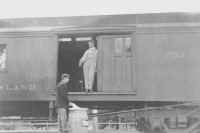
George G. Ayling reviewing express invoices
- Brentwood - 1909
G. G. Ayling collection
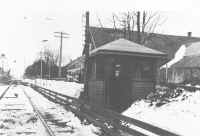
"CP" cabin - Central Islip 1914
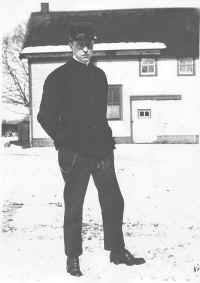
Assistant Station Agent George G. Ayling in
uniform cap - Central Islip 1918
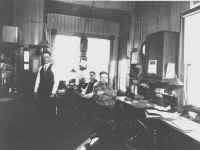
Central Islip station and block office -
interior view - December/1928
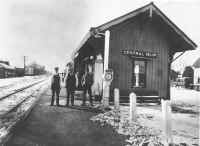
Central Islip station - looking west -
December/1928
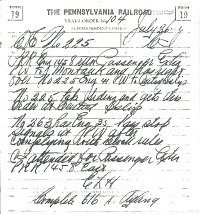
Form 19 train order issued at
Central Islip - 7/26/41
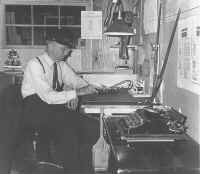
George G. Ayling in uniform cap with
Vibroplex telegraphic key in
simulated block office created by Dave Keller - 6/71

LIRR Station Agent badge - c. 1880s
(Worn by John Bonn, agent at Lindenhurst)

LIRR Station Agent badge - c. 1920s
(Worn by George G. Ayling, agent at Central Islip) |
Tom Bayles
When I was about 15 years old, I was looking through the vertical files in
the reference section of the Patchogue Library and came upon a Brookhaven
Town historical pamphlet published by one Thomas R. Bayles of Middle Island,
N.Y. On the rear cover was a terrific shot of the Medford depot taken in
1940, prior to the grade elimination.
I mentioned the pamphlet and great photo to my father who said he knew Tom
Bayles, as he was the ticket clerk at Patchogue for years. He used to
give my father vegetables from his garden. (As mentioned in a previous
story, my father commuted on the L.I.R.R. from Patchogue beginning in the
late 1940s until his retirement in 1967.) Tom had since retired (1959)
after 45 years of service.
We looked him up in the phone book and he was still living in Middle Island.
My father renewed an old acquaintance and I created a new friendship with
both Tom and his wife Gertrude, which lasted for many years.
Thomas R. Bayles was born in Middle Island, N.Y. in 1895, the son of Richard
M. Bayles, a surveyor, realtor, notary public and, most importantly, Long
Island historian. Richard M. Bayles wrote and published the book
Sketches of Suffolk County in 1873 (I'm lucky to have a copy of this book, a
present from Tom.)
Tom followed in his father's footsteps in his love of Suffolk County history
and became the unofficial Brookhaven Town Historian, publishing loads of
pamphlets of Brookhaven Town history, most times at his own expense,
sometimes getting a bank or other business as a sponsor. Either way,
he would give these illustrated pamphlets away for free, in the hope of
creating interest in local history.
Tom Started as a ticket clerk on the L.I.R.R. in 1914. He would pedal
his bicycle daily from Middle Island to either the Miller's Place or
Shoreham stations, where he started out as a relief clerk during the summer
months. He would also deliver, by bicycle, Western Union telegrams
addressed to the townspeople of Shoreham, then pedal home again at the end
of a long day's work.
He was assigned to Westhampton in 1915 and had to get an automobile.
He left the L.I.R.R. for a several year stint on the New York, New Haven and
Hartford R.R. in Connecticut. He returned to the L.I.R.R. and worked
in the freight department at Camp Upton for 5 years starting in August,
1917. He was the last L.I.R.R. employee on duty when the freight
office closed on April 15, 1922. After WWI ended, he got permission
from the camp's commanding officer to take photographs. These are the
only known photos in existence today of the L.I.R.R.'s involvement at the
camp. His non-railroad shots of the camp are just as rare!
In later years he wound up at Patchogue, remaining there until his
retirement.
Tom often gave the impression of being a "country bumpkin", both in his
speech and mannerisms, but don't be fooled! He was a highly
intelligent and savvy man, especially when it came to business. He was
just quiet, liked to spend hours farming and went swimming frequently at
Cedar Beach in Rocky Point right up until his death. He and his wife
attended several churches every Sunday and they were both good people!
During the L.I.R.R. presidency of Thomas R. Goodfellow, retirees were given
"Lifetime" passes to ride the L.I.R.R. free of charge. Many times I
rode into Penn Station in Manhattan with Tom, on his pass, free of charge.
This courtesy was afforded us by fellow trainmen who knew him. He even took
me on a trip on the New Haven R.R. to Bridgeport, Connecticut and on the
Pennsy to Philadelphia, PA using this L.I.R.R. pass! Railroad men of
other roads used to afford this courtesy to each other, unofficially.
Tom's long and productive life came to an end on 6/29/77 when he was killed
in a automobile crash. His wife and their close friend were both
injured but not severely and survived.
1. 2nd depot building at Miller's Place - 1915 - photographed looking
east from the express platform by Tom Bayles as a young ticket clerk.
2. Shoreham station - 1912 - trackside view looking north. Tom
Bayles said this depot was very fancy, including wicker furniture in the
waiting room (T. R. Bayles collection, probably photographed by his brother
Albert Bayles, also a L.I.R.R. man and very good photographer. The
Medford shot that caught my attention was one if his!)
3. Shoreham depot plaza, showing, from L. to R.: freight house, North
Country Road grade crossing, depot and grounds and express house. Tom
Bayles climbed to the top of Nikola Tesla's abandoned experimental radio
tower in 1914 and shot this view looking north. He then went to the
other side of the tower and photographed the next shot.
4. Open touring car on unpaved Route 25A as viewed from Tesla's tower
- Shoreham, NY - 1914 (T. R. Bayles photo)
5. Tesla's tower and laboratory building as viewed from the Shoreham
station, looking south - 1914 (T. R. Bayles photo)
6. Westhampton station with returning Fourth of July crowd - 7/5/15.
View looking west from the express platform. Look at all those summer straw
hats! (T. R. Bayles photo)
7. Camp Upton station (tar-papered shack) - 1918 (T. R. Bayles photo)
8. L.I.R.R. annual passes for Tom Bayles and his wife Gertrude for
1950-1951 (T. R. Bayles collection)
9. Example of a "Goodfellow"-era L.I.R.R."Lifetime" pass issued to
retired engineer George Dickerson - late 1950s (Jeff Skinner collection)
10. Thomas R. Bayles obituary from the Long Island Advance of 7/1/77
(The retirement date noted is incorrect. It should read 1959, not
1969)
|
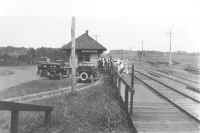
2nd depot building at Miller's Place - 1915
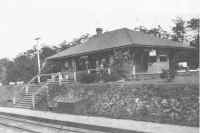
Shoreham station - 1912
trackside view looking north
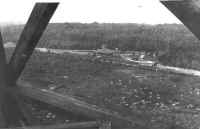
Shoreham depot plaza, showing, from L. to
R.: freight house, North Country Road grade crossing, depot and grounds and
express house
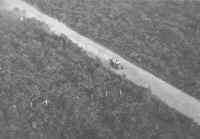
Open touring car on unpaved
Route 25A - 1914
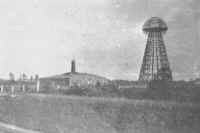
Tesla's tower and laboratory building
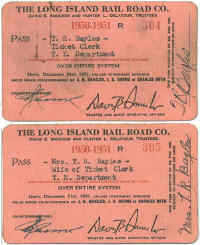
L.I.R.R. annual passes for Tom Bayles and
his wife Gertrude
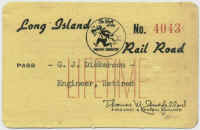
"Goodfellow"-era L.I.R.R."Lifetime"
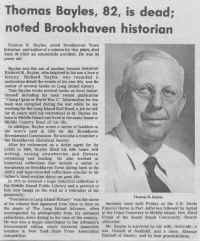
Thomas R. Bayles obituary from the Long
Island Advance of 7/1/77
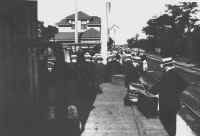
Westhampton station with returning
Fourth of July crowd - 7/5/15
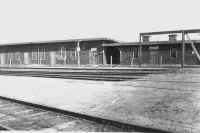
Camp Upton station
(tar-papered shack) - 1918 |
The Pocket
Watch
Since railroading began, keeping to the timetable has always been a priority
for train and engine crews. Leaving a station late would make your
train late at your meet. The train waiting for you on the siding would
then be late as a result, and so on and so on. This could be
especially disastrous on a long distance run with many station stops and
meets. Engine crews would attempt to make up lost time by occasionally
exceeding the speed limit.
Time was a very important thing to railroad men and railroad men kept track
of this important commodity with a pocket watch; and not just any old pocket
watch, but a "railroad" pocket watch.
Old-time passenger train crews were required to wear a dress uniform of blue
serge wool in all weather, consisting of vest, jacket and cap, in addition
to a dress shirt and tie! Summer caps were issued that had a
ventilation mesh sewn around to allow some air to reach the head. That was
about the only concession to the summer allowed. (Even some engineers wore
neckties under their overalls!) Add to this constrictive clothing the
carrying of a heavy employee timetable, book of rules, fare tariff charts,
ticket stock, paper money and change, seat checks, ticket punch, ring of
coach and switch keys, and work must have been very uncomfortable especially
during a Long Island July and August!
In their vests the train crews wore their pocket watches. (Most men, prior
to the 1940s wore vests with their business suits as it was the style of the
times. Many wore pocket watches in those vests.)
The pocket watch was usually placed in one vest pocket and the watch chain
was looped through a buttonhole and set in the other pocket with some sort
of miscellaneous item on the end for weight, such as a small pen knife or a
special key or personal locket.
There was also another type of chain used which had a retaining bar at the
end. This bar would be slipped into one of the upper vest buttonholes
and the chain draped to one vest pocket where the watch resided.
Usually a decorative "fob" (ornamental piece of jewelry, etc. ) hung from
the upper portion of this style chain at the buttonhole level.. (I have a
fob from Jeff Skinner that was made by some skilled person who had cut the
LIRR keystone logo from two uniform jacket buttons of the 1940s and soldered
them together with a filler piece, attaching a ring at the top to allow the
fob be affixed onto the chain.)
Engine crews would wear their watches in the top pocket of their bib
overalls and attach the chain through a buttonhole sewn into the bib
specifically for that purpose. This provided an engineer quick and easy
access to his watch while seated at the throttle
Do you ever see the same style pocket watch for sale
on e-Bay but all the cases are different? Prior to about 1920,
watches were purchased separately from their cases. One would have a
certain amount of money to spend on a watch. Those for whom the
accuracy of the watch was tantamount, would purchase a certain costly
works from their local jeweler then choose a cheaper case from a catalogue
in the store. The jeweler would either have the case in stock or
would order the case whereupon he would then put the quality works inside
the case and you had your watch.
Others, to whom cosmetic appearance was more
important, chose an expensive case and, whatever money was left, purchased
a cheaper quality watch to have set in the case.
As the railroad pocket watch had to meet such strict
specifications, it was not a cheap item and needed to be placed in a
decent case due to the heavy use it would receive over the next 35+ years
of railroad use. Some cases were replaced as many as three times
over the lifetime of the railroad man’s career.
The railroad pocket watch was distinctly different from the ordinary pocket
watch in several ways:
First, it had a special 19, 21 or 23-jewel movement that was designed to
keep accurate time in 5 or 6 positions depending upon the model, as a
railroad man in train service (especially in freight service) could be
jostled and/or might be climbing, squatting, bending over, etc. while
performing his daily duties. A towerman would be throwing switch and
signal levers throughout his daily “trick.” A station agent or
ticket clerk would be lifting, loading and unloading baggage and express
items throughout their busy day.
Second, the front crystal (bezel) had to be removable, allowing access to
a small lever which, when pulled out, allowed one to set the hands of the
watch, the lever then being pushed back in and the crystal replaced.
This protected the hands from becoming "un-set" if bumped, etc.
while going through the gyrations mentioned above.
Third, the numbers on the face had to be large, bold, and easily readable
(no Roman numerals or tick-marks for the hours!)
There were many companies that manufactured
railroad-grade watches, such as
Elgin
and
Waltham
. One of the most popular and oldest ones was the Illinois Watch
Company. These watches featured the "Bunn Special," a
21-jewel movement designed for railroad use. Another of their models
featured a 60-hour movement! Arriving on the scene in 1893 was the
Hamilton Watch Company which produced their various railroad models i.e.
950, 992, 992B, et. al.
Hamilton
later bought out the Illinois Watch Company and continued to produce
high-quality railroad-grade pocket watches until their last run in 1969.
Railroad men had to submit their pocket watches every 6 months to a
railroad-approved jeweler who inspected, cleaned and set the watch according
to railroad standards. I guess all railroad men had to have an inspected
"back-up" timepiece during these inspections.
Crews would frequently set their watches by the "Regulator" depot clocks
hanging on the walls in every ticket office on the line. They would
also compare watches with each other to make sure they were all on the same
time. (Sort of like those old war movies where the soldiers would
"synchronize" their watches before going on a mission.) (See the photo
accompanying my earlier story "The Beginning of a Railfan" where we see
Conductor and Trainman comparing watches before leaving the station.)
As years passed, wrist watches took over as the timepiece of choice (and
convenience). Strict adherence to time became lax to such a point that
the radio would report daily on their morning traffic delays that the
railroad was running "on or close to schedule." A old, retired
engineer once told me that if he ever ran "close to schedule" he would have
gotten a reprimand and /or fine!
This is kind of ironic. A watchmaker recently told me that "railroad
approved" watches are no longer being newly manufactured because quartz
movements are so very accurate these days. We now have timepieces
accurate to the second and no longer require regular setting and adjusting
and "being on time" is no longer a number one priority to most people.
I guess the "old railroader" and the pocket watch are from a "time long ago
and a galaxy far, far away."
1. Illinois "Bunn Special" pocket watch manufactured in 1923 and given
to George G. Ayling by his wife Emma as a present upon his
promotion to Station Agent in 1923. George present this watch to
me in 1972 on my 20th birthday and I've treasured it ever since. I
still wear it in the watch pocket of my pants. (NO vests in Florida:
too hot!!!)
2. L.I.R.R. "Dashing Dan" leather watch fob used in lieu of a chain.
It
would hang out of your pocket for easy access, but it also allowed
one to lose their watch if they weren't careful. (Dave Keller
collection)
3. Engine crew of H10s #108 comparing watches at Holban Yard -
Hollis, NY - 11/26/54 (Edward Hermanns photo)
4. L.I.R.R. "Employees Certificate" indicating that the pocket watch
of
Trainman George Bookstaver had passed inspection.
(George Bookstaver collection)
5. Positions in which the watch and chain or fob could be worn in
vests
and overalls. (Sketch by Dave Keller)
6. My Seiko quartz "Railroad Approved" wrist watch of the 1990s which
I
still wear daily. (The most accurate timepiece I've ever owned!)
|
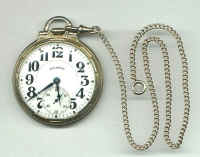
Illinois
“Bunn Special pocket watch manufactured in 1923. (A railroad watch
had to be accurate to within 30 seconds a
week.)
Illinois
was bought out by
Hamilton
in 1927.
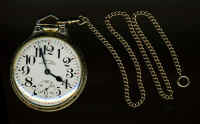
Another fine pocket watch that was carried
by railroad men was the
Hamilton
Railway Special.
Several models were available and one of the most popular was the 992,
followed some years later by the 992B.
The above watch is a model 992, with a serial number that dates its
manufacture to 1915. It has 21 jewels and is adjustable to temperature
and 5 positions. (The later, 992B was adjustable to 6 positions.)
It hosts a
Montgomery
dial, where all the minutes are indicated as numbers in lieu of “tick”
marks as well as a bar-over-crown case. (The second-hand in this scan
appears to be broken, but it was actually moving when the scan was made and
the scanner does not stop action.)
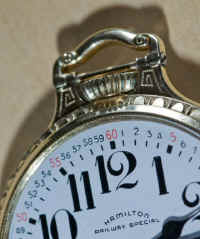
Close-up of a later, similar case depicting
the bar-over-crown style.
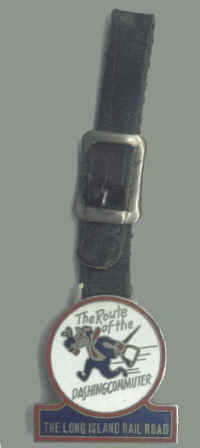
L.I.R.R. "Dashing Dan" leather watch fob
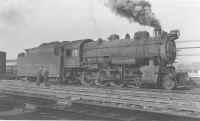
Engine crew of H10s #108 comparing watches
at Holban Yard - Hollis, NY 11/26/54 (Edward Hermanns photo)
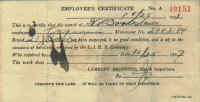
L.I.R.R. "Employees Certificate" indicating
that the pocket watch of Trainman George Bookstaver had passed inspection.
(George Bookstaver collection)
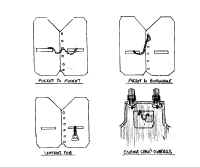
Positions in which the watch and chain or
fob could be worn in vests and overalls. (Sketch by Dave Keller)
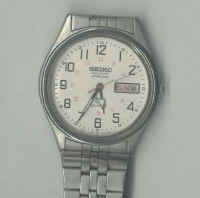
Seiko quartz "Railroad Approved" wrist watch
of the 1990s |
Railroad
Telegraphy
Before the days of telephone, radios, cell phones and Nextel-type
radio/phones, there was Morse code. This was named, of course, after
it's inventor, Samuel F. B. Morse (who sent the very first telegraphic
message in 1844 to wit: "What hath God wrought?")
Messages had to be sent both quickly and accurately and the only thing that
came to mind at first was a series of horse riders running messages in
relays from one station to another outwitting bandits and Native Americans
along their routes. We know this as the Pony Express. It
received much glamour in the movies and stories, however, the Pony Express
lasted only one short year. It was put out of business by Mr. Samuel
F. B. Morse's invention.
The Morse code sent messages electrically (via wet-cell battery) through a
wire using a series of dots and dashes which represented letters and
punctuation. The telegraph operators had to learn this new "language"
and interpret it.
Retired LIRR station agent George G. Ayling told me that a telegrapher
didn't listen to individual letters, but, rather, listened to and
anticipated entire words. (Sort of how we hear conversations. We don't
hear letters at a time, but entire words. And if you've never had your words
anticipated, just try talking with your wife!)
Cutting through the general history lesson, and to make what could be a very
long story short, telegraphy became the main means of communication on the
railroad, as well as throughout the United States and the world and was used
on American railroads well into the 20th century, long after telephones were
in common use! Kind of tells you of it's reliability and the
confidence that people had in the system.
The LIRR was no exception. Not only were Western Union telegrams
received and sent at the local ticket offices, as a service to the
community, but the system of dispatching trains via train orders (both Form
19s and Form 31s) was done via the telegraph. (Note: a Form 31, for you
youngsters, was a train order which the train crew did not catch on the fly
from a "Y" shaped stick, or hoop, but had to stop and sign for it! For
obvious reasons, they were not around for long)
The Dispatcher's office (at first in L. I. City, and after 1913, in Jamaica
when the railroad's general offices were moved) would send out a train order
to an individual station.
The telegraph system was like one big party line (again for the youngsters:
a party line was the old rural telephone service whereby you picked up your
phone and could hear other people on the same line talking. You had to
cut in to make your call: "Edna, please get off the phone! I
have to call Dr. Johnson!" or: "Ruthie! Did ya hear? Molly
Stevens is having an affair with the ice man!" ). Every station along
the line would hear the tap-tapping all day long of messages
going to various block offices. The operators learned to block out all
the messages that weren't for them. They would perk up once their
Telegraphic Call Letters were sent over the wire. They would then get
on the wire and respond by repeating their call letter to acknowledge that
they were present and ready to copy a train order or take a telegram.
Every station and block office had it's own distinctive call letters. Some
had separate letters for the telegraph and block offices, such as Patchogue.
Originally "P", it became "PG". When "PD"
tower was opened and the block office moved from the depot building, the station
retained "PG" for telegrams and the block office used "PD" for train orders.
As if listening to all that tapping all day long wasn't bad enough, the
operators would put their sounder, that part of the telegraphic equipment
that received and "sounded out" the message, into a wooden contraption
called a resonator. This would capture the sounds and focus them
towards the ear of the operator sitting at his desk. To increase that
sound even further, the operator would sometimes flatten out a metal tobacco
tin, and jam it behind the sounder in the resonator!
The telegraph key was firmly screwed to the desk top and, contrary to
popular belief and as portrayed in movies, was not tapped with one or two
fingers, but grasped firmly with at least 2 fingers and thumb, and held
firmly while sending the message.
Telegraphers who wanted to be "speed demons" could purchase, at their own
expense, a "bug." This was the nickname given to the Vibroplex
"Lightning Bug" model of mechanical telegraphic key. Instead of the
conventional and wrist-straining up and down movement, this key went side to
side. If the operator wanted dashes he held the key to one side. If he
wanted dots, he held it to the other side, and to speed up the process, if
he held the key to the dot side, he would get a steady stream of dots, sort
of like holding down a key on an electric typewriter or computer keyboard
and the key repeats itself until you let go.
Operators got to know other operators' style of sending, which they referred
to as their "fist." They would hear someone's "fist" and know immediately
who the person was before they even identified themself.
The operators also had to take a test every so often to make sure they were
up to snuff in sending and receiving accurately. They also had their own
union. The O.R.T. or Order of Railroad Telegraphers represented block
operators on the L.I.R.R.
(All illustrations are from G. M. Dodge's 1911 handbook
The Telegraph Instructor unless otherwise noted)
1. The Morse Code used on the railroads and in Western Union offices
was the American Morse Code. This code differed from the International
Morse Code, in that the American code inserted spaces between dots in some
letters and numbers and punctuation were different. I believe the two
codes were designed purposely to be different so there could be no
confusion. These pages show the differences between the two alphabets
and numbering and punctuation systems.
2. Title page to G. M. Dodge's 1911 handbook The Telegraph
Instructor.
3. Engraving of a typical telegraph key
4. Engraving of a typical telegraph sounder
5. Engraving of a typical telegraph wet-cell battery, usually kept
under the operator's desk. Lots of liquid battery acid there!
6. Drawing of a main line telegraph circuit
7. Order of Railroad Telegraphers membership cards - 1952-53
for George G. Ayling, L.I.R.R. station agent at Central Islip
(G. G. Ayling collection)
8. LIRR Union pins. Order of Railroad Telegraphers is in the
center of the display (the sounder within the wreath)
(J. Skinner and G. G. Ayling collections)
|
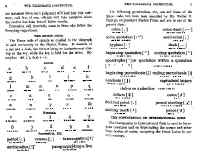
American Morse Code used by
railroads and telegraph offices
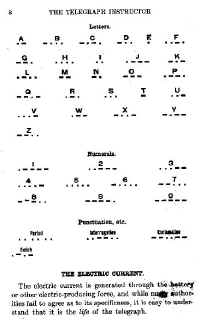
International Morse Code
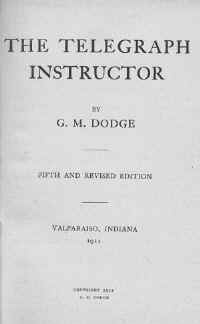
Title page to G. M. Dodge's
1911 handbook
The Telegraph Instructor
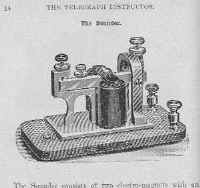
Typical telegraph sounder

Typical telegraph keys
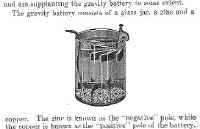
Typical telegraph wet-cell battery
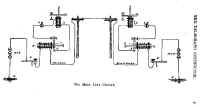
Main line telegraph circuit
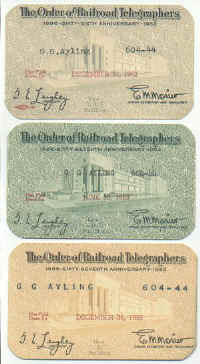
Order of Railroad Telegraphers membership
cards - 1952-53
George G. Ayling
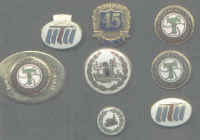
LIRR Union pins |
| The
Manorville Branch
This line was originally the
Long Island Rail Road ’s Sag Harbor
Branch until the South Side Rail Road was merged into the L.I.R.R. and its
South Side Division which had been extended from Patchogue eastward was
connected with the L.I.R.R. west of Eastport. The L.I.R.R. depot at
Moriches, now located along what was to become the Manorville Branch, just
south of South Country Road crossing was moved further east and became the
new Eastport station.
When the L.I.R.R. was extended from
Bridgehampton eastward to Montauk in 1895, the Sag Harbor Branch became only
that spur from Bridgehampton to
Sag Harbor. What had been
the original Sag Harbor Branch was now called the Manorville Branch,
connecting Manorville (previously Manor) on the
Main Line with Eastport on what would now be called
the Montauk Branch.
Manor, originally called Punk’s Hole and
later, Manorville, was a very important junction.
There was a depot building containing the block office whose
telegraphic call letters were designated “MA”, a water tower, and the
longest passing siding on the entire railroad system. On
8/5/16 “MR” cabin was
opened just west of the depot at the switch to the junction and the block
operator was moved from the depot to the cabin.
That same year a similar block
cabin was installed at Eastport Junction and designated with the telegraphic
call letters “PT”.
Originally, trains bound for
Montauk would, on occasion, be routed through the
Main Line , and then cut across to the
South
Shore
via this branch. Other trains, such as the “Scoot” would run from Greenport
west to Manorville, make a reverse move at the junction and head back east
again over the Manorville Branch to Bridgehampton and Sag Harbor and return.
These reverse moves at
Manorville ended when the wye was installed there in 1887. There was also a
wye installed at the connection to the Montauk branch at Eastport but not
until 1917.
The Eastport wye wasn't actually
a wye in the true sense of the word, in that the Manorville branch was
pretty much a straight run to Eastport and the Montauk branch made a
sweeping curve west of the junction at Eastport. The west leg of the "wye"
at Eastport connected further west of the junction. It was more of a spur
off the Manorville branch.
These wyes allowed ease of
movement in all directions, such as coming from Greenport and "rounding the
horn" to head to Sag Harbor and vice versa, or routing trains from Camp
Upton east to Manorville, then west on the Montauk branch.
I was told by a WWI-era block
operator that troop trains were sent eastward over the Main line to Camp
Upton and the empties sent further east to Manorville, then via that branch
to Eastport and then back west.
This way there could be a
constant flow of eastbound troop trains to the camp and a solid flow of
westbound empties, or troop trains filled with newly-trained soldiers
("doughboys") headed westbound without any right of way issues, and any time
wasted "going in the hole" for anyone else!
One big circuitous route!
Also, the wyes were curved
broadly enough to allow this to be done at a fairly good speed.
In the early days, the
"Cannonball" consisted of a two-part train (double consist of cars). It was
pulled eastbound towards Greenport along the
Main Line .
At Manorville, the train was cut
in two. The first half continued on to Greenport. The second half coasted
onto the Manorville branch and coupled with a waiting locomotive(s) for
continuation on to Montauk! This (OSHA look the other way) was done without
stopping and passengers on board!
It was explained to me by an old
railroader many years ago that the engine(s) waiting on the Manorville
branch were idling, ready and waiting. As the first half of the train
approached the junction, the 2nd half of the cars were cut loose. The
engineer was given a signal and he accelerated out of the way.
As he cleared the switch to the
junction, the operator would throw the switch and the coasting cars, most
probably being manually braked by the brakeman would enter the Manorville
branch.
The locomotive(s) waiting for
these cars would then begin to move eastward along the branch, just fast
enough to stay ahead of the coasting cars. The cars would then gently couple
into the rear of the locomotive(s) tender(s).
No thumping, no banging, no
whiplash-producing moves. Just a clean flow.
As I said: railroading skill at
it's finest!
I wish I was there to see it. (I really wish I was there to photograph
it!!!!)
The L.I.R.R. shut down the
Manorville Branch in 1949 and was quick to tear up the tracks!
A railroader around at the time this was done told me that it was the
L.I.R.R.’s position that they were saving lots of money in salvaging the old
rail for use elsewhere. (Where???)
The depot building at Manorville
along with “MR” cabin and the junction connection were removed that same
year and a concrete shelter-shed erected for passengers. The west leg of the
wye at Eastport was taken out of service much earlier, on 2/19/31. “PT”
cabin at Eastport was closed in September of 1938 and the block signals
removed.
The LIRR made a major mistake
shutting the Manorville branch down in 1949. No one seemed to plan on future
growth and needs! Also, no one seemed to realize or to think it was
important that there was no way to get from the
Main Line to the
South
Shore unless one traveled all the way back
into Nassau County, going miles out of the way.
Explanation of illustrations:
1. Form 19 train order issued at
“PD” tower, Patchogue in 1934 showing a Montauk bound train running extra,
being routed via the Main Line from “PW” cabin west of Pinelawn eastbound
via the Manorville Branch to “MY” (Montauk’s call letters)
(Dave Keller collection)
2. Block
Operator James V. Osborne standing outside “MR” cabin – Manorville - 1921.
(view looking east towards the junction and depot)
(Copy from a photo given to me personally by Jim
Osborne. Original negative in
the collection of Ron Ziel)
3. Form 19
train order issued by operator James V. Osborne at “MR” cabin – Manorville
–1921 (J. V. Osborne collection)
4. Form 19
train order issued by operator James V. Osborne at “PT” cabin – Eastport –
1922 (J. V. Osborne collection)
5. Close-up scan of
“PT” cabin viewed from signal mast looking west up the Manorville
Branch (straight ahead) with Montauk Branch curving off to the left – 1923
(J. V. Osborne photo)
6. View of
the signals at Eastport Junction looking east from the Montauk Branch
towards “PT” cabin. The
Manorville Branch is coming in on the left – 1923 (notice which branch had
the right of way!)
(J. V. Osborne photo)
7. Similar
view only looking east from between the Manorville and Montauk Branches –
1923 (J. V. Osborne photo)
8. E51sa
camelback #4 pulling the “Cannonball” eastbound on the Manorville Branch
approaching Eastport Junction – 1923 (view looking west from signal mast.
Montauk Branch curving off to left)
(J. V. Osborne photo)
9. E51sa camelback #?
pulling eastbound train off the Manorville Branch at “PT” cabin – Eastport –
1923 (view looking west)
(J. V. Osborne photo)
|
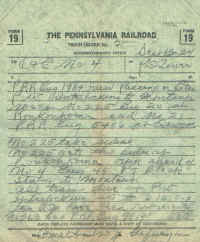
Form 19 train order issued at “PD” tower,
Patchogue in 1934
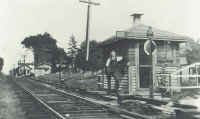
“MR” cabin – Manorville - 1921
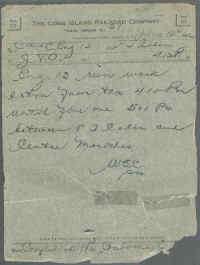
Form 19 issued at “PT” cabin Eastport 1922
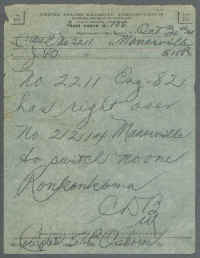
Form 19 issued at “MR” cabin
Manorville 1921
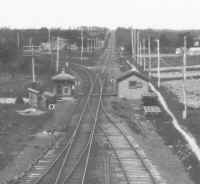
“PT” cabin viewed from signal mast looking
west up the Manorville Branch (straight ahead) with Montauk Branch curving
off to the left – 1923
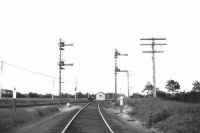
Eastport Junction looking east from the
Montauk Branch towards “PT” cabin.
The Manorville Branch is coming in on the left – 1923
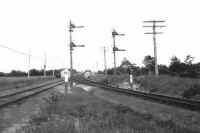
Looking east from between the Manorville and
Montauk Branches – 1923
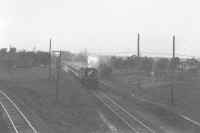
E51sa camelback #4 “Cannonball”
eastbound on the Manorville Branch approaching Eastport Junction – 1923
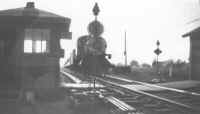
E51sa camelback #? eastbound train
off Manorville Branch at “PT” cabin
Eastport – 1923 |